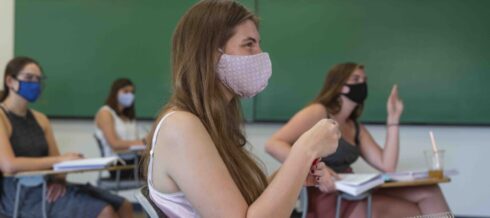
As a cognitive psychologist, I appreciate that the mind likes structure. It helps us make sense of novel input, guides predictive inferences as we learn, and allows for more successful retention of information. In the classroom, the structure is reflected in how the material is organized as well as how we work with that material. In pre-COVID classes, I would provide a mixture of active lectures, activities, and discussions most every day. Each plays an important role in the learning process – establishing a conceptual foundation, exploring the application of the concepts, and making meaning. The mix kept things interesting, but I always had to be mindful to draw out connections during class. With the turbulence, I expect this fall, I have decided to draw out the structure as much as I can so the students can recognize it even without my ongoing direction. Also, given the increased likelihood of disruption, I want the structure of the class to be laid bare so it is easier to pick up and reconnect if a student (or myself) has to miss any classes.
Initial Coverage of Material (Monday)
I plan to start the week with asynchronous and remote coverage of basic material. Each week we will focus on a selection from the textbook and several pre-recorded lectures (posted to youtube). A reading guide will specify critical concepts to look for as well as questions that focus on basic comprehension of the text. The pre-recorded lectures (every 10-15 minutes in length) will provide an overview of the concepts from the textbook along with additional material relevant to the topic at hand. Embedded in the lecture videos are “pause points” where the students are instructed to work through a question that checks their understanding of the material. These asynchronous activities will be coordinated with a class discussion board (in Notebowl) where the students can share insights and/or questions and help one another establish an initial understanding of the material. I will also be available to meet individually with students who want additional support.
Activities and Demonstrations (Wednesday)
We will then meet as a class – in-person and remotely – to participate in demonstrations and explore examples that will help to ground the material. For instance, if the textbook and lectures introduced students to the topic of attention, we will use this session to watch some demonstrations of inattentional blindness (e.g. the classic gorilla study videos) and review basic research findings. These activities will allow the students to make sure they understand the basic concepts from earlier in the week and how those concepts apply to particular situations.
Integrative Tutorial (Friday)
At the end of the week, I plan to meet students in small groups (5-6) for 30-minute tutorials to discuss how the material connects to their lives (especially issues from other classes and/or extra-curricular activities). Students will receive prompting questions on Wednesday, so they can organize their thoughts before we meet. Following the session, students will submit a short, written response so they have the opportunity to synthesize and reflect on the ideas we share. The tutorials will be either in-person or remote depending on the availability of the students. Although these sessions will increase my contact hours at the end of the week, I can minimize that impact by scheduling tutorials during our class meeting time and using the time I might normally set aside for office hours. Also, I anticipate that this class structure will decrease the amount of time I devote each day to course preparations because I can consolidate the work associated with each component of the class.
Conclusion
By simplifying the structure of the course and creating a predictable rhythm, I hope to improve my students’ learning and reduce their anxiety during these challenging times. Although some of the spontaneity I typically enjoy will be lost, it will be easier for the students to keep in mind how each activity connects to their learning experience. Successful students are able to monitor their comprehension and decide how to best leverage different strategies as they learn – it is my intent that this course structure will help students develop those abilities.

Seth Chin-Parker
Associate Professor
Psychology/Neuroscience
